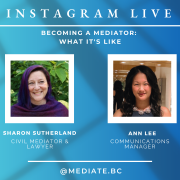Tue 08 Sep 2015
Have Courage, Robin: A New Narrative for New Dispute Resolution Practitioners
Posted by Heverton.Oliveira
When I was called to the bar, the Law Society had a provision requiring lawyers to practice law for at least three years prior to conducting a family law mediation.
It was many years before the Law Society changed this requirement, and I was never able to figure out the logic behind these facts: there was no prohibition against conducting a murder trial shortly after being called to the bar, yet there was a prohibition against acting as a family law mediator.
Reading Robin Phillips' 10 Common (and Discouraging) Pieces of Advice Offered to New Dispute Resolution Practitioners, I am concerned that lawyers are building a narrative that has replaced the Law Society’s prohibition, and may be just as effective in discouraging newly called lawyers from building a dispute resolution practice. Have we replaced the Law Society’s “You are not allowed to” with: “Trust me (and my grey hair). You will never succeed.”? In examining Phillip’s list of Mediation Myths, let me suggest a new narrative for our times.
Myth #1: Litigate for ten years before mediating
Basic neuroscience does not support this. Why spend ten years developing specific neuropathways that are not only useless in mediation but may actually interfere with your dispute resolution skills? As a sixteen year old in Japan, I was the only left-handed student in my high school. I know there were others who showed an early preference for their left hand, but consistent with Japanese culture, this was discouraged and all learned to use their right hand. At sixteen, the effort to make this change seemed impossible. Basic neuroscience was working for all those Japanese toddlers. Let it work for you.
Myth #2: (a circular argument) no one will hire you until you have built a good reputation, and you can’t build a good reputation until you have mediated many cases & Myth #3: you need a head full of grey hair
Grey haired mediators are expensive and not everyone can afford their hourly rates. As well, I have noticed that the more comfortable we are with our skills, the less likely we are to continue learning and building new skills. Professionally, I believe we have an obligation to support and encourage newly called lawyers to develop their skills as mediators, ensuring a broader section of the public can afford our services. I also believe that the “fresh edge” of mediation, the courage to try new techniques and approach practice from a true interest based perspective as opposed to a strongly evaluative perspective often rests with younger practitioners eager to build and expand their skills.
Myth #5: you must have a split practice & Myth #9: you can’t have a split practice
OK, now I’m dizzy! I see the “practice” distinction differently. Some lawyers combine forms of consensual dispute resolution with litigation, others limit their practice to consensual dispute resolution and no court work. What I know is that the public (the people we serve) need all kinds of services. The question, as I see it, is: how do you choose a practice life that is compatible with your values, personality style, and how you want to spend the significant number of years you will work in this profession? For me, the answer to these questions has led me to build a practice that includes mediation, Collaborative Practice, Views of the Child Reports, teaching, and synthesizing research and writing in the consensual dispute resolution field. For someone else, it might be a combination of mediation and unbundled services. Listen to what the clients that come through your door need, and be creative in brainstorming process options with your clients. This may be your most valuable opportunity to learn. Senior practitioners with a strong mediation practice have a certain lens. As a newer practitioner, you have the advantage of not being burdened by the status quo. Be curious. Give permission to your passion. In addition to mediation, offer coaching to those negotiating on their own or to those attending mediation without counsel. Think about offering distance mediation, and market this to smaller, rural communities. It is time we shift our thinking beyond the “mediate or litigate” paradigm and think creatively about offering the services clients need and can afford.
Myth #4, 7 and 10: variations on don’t try, there is no room for you and you will never make money
The use of mediation is increasing. The number of civil trials is decreasing. Yet we don’t tell new lawyers, “Don’t practice litigation, you will never make a living at it.” Why do we reserve this caution for new lawyers wanting to practice dispute resolution? Thank goodness Stu Webb did not take this message to heart when he decided on something new: Collaborative Practice.
Myth #6: Mediation is falling out of fashion, and is no longer a growing area
I asked my eleven year old granddaughter if she learned anything new at Leadership Camp. “Not really,” she replied. “What did they teach you,” I asked. “Conflict resolution,” she answered, implying this is nothing new to an eleven year old. Mediation and other forms of consensual dispute resolution have finally become a wave large enough to observe. I believe we are responsible for ensuring our profession continues to grow and adapt to provide needed services, services congruent with a growing public vision of resolving disputes, or we may be in danger of “lawyers falling out of fashion.”
Myth #8: Certain sectors may not take a female mediator seriously
Would these sectors be populated mostly by men? Are we telling women lawyers to stay away from practicing in these areas? Or female judges not to hear these cases? Thank goodness we have Madam Justice Beverly McLaughlin as a role model. I am not so naïve as to believe that gender bias no longer exists. Nor am I so fearful or exhausted as to turn and walk away because of it. I am fueled by Gandhi’s simple suggestion: “Be the change you want to see in the world.” I believe this is the most powerful tool we possess for creating change.
Have courage, Robin, and all the other newly called lawyers that want to build a dispute resolution career.
Our profession needs you.
The public needs you.
May we provide the support and encouragement you deserve as you create the new normal and help change our litigation-centric narrative.

Guest blogger Nancy Cameron is a lawyer who limits her practice to mediation and collaborative practice, a writer, and an educator. She has led and designed training in dispute resolution and has been an adjunct professor at both UBC Law School and HKU. She is also a Mediate BC Family Roster mediator.
To compliment Nancy's post addressing these myths for lawyers embarking on careers in dispute resolution, the next post will be Darrin Hotte's response to these myths.
This is the third post in Sharon Sutherland's curated series on First Careers in ADR.
Photo by Paul Gilmore on Unsplash




